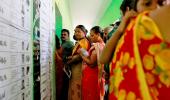If the decline reflects a loss of faith in the democratic process, even a well-executed social media nudge may not help.

Around 340,000 more people turned out to vote in the United States in 2010 because of a 'single election-day message on Facebook', according to a 2012 study published in Nature magazine.
The rise in turnout followed an experiment on 61 million Facebook users.
The worry about voter turnout in India's ongoing parliamentary elections follows a strong show in 2014 and 2019.
Turnout was under 67 per cent in the first two phases of the seven-round elections.
It is 3-4 percentage points lower than in the same seats in the 2019 election.
The number reflects the percentage of people who vote among those registered to vote.
Not everyone is a registered voter. The share of people who have voted as a percentage of the voting-age population gives a clearer sense of democratic participation and throws up an interesting trend.
Logically, the turnout rate among the voting-age population should be lower than that among registered voters.
This is because the denominator in the case of the voting-age population is larger even as the number of voters remains the same.
But this was not always found to be true in India as seen in chart 1.

That may be due to methodological issues or errors in population estimates, but there are instances where the number of registered voters seems larger than expected.
Maharashtra and Rajasthan have thousands of registered voters who are over 100 years of age.
A look at the difference between the voting-age population estimate and the number of registered voters shows there were often more registered voters than people of voting age.
The gap between the two was 19 million voters in 2019, and this is not the highest on record (chart 2).

By either measure, India's voter turnout is lower than in several emerging markets. It is closer to Germany, France, and the United Kingdom (chart 3).

Heat waves and long elections are said to have a limited effect on voter turnout.
If the decline reflects a loss of faith in the democratic process, even a well-executed social media nudge may not help.

Feature Presentation: Aslam Hunani/Rediff.com












 © 2025
© 2025